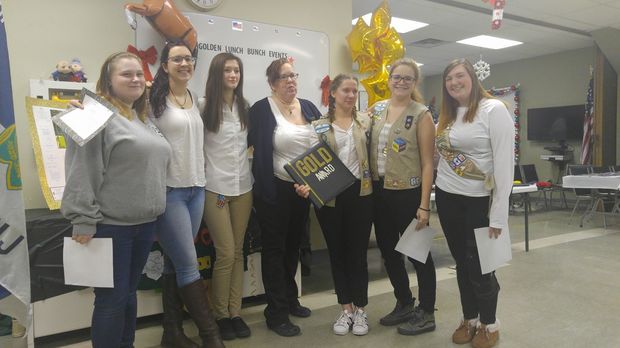
by RVCS | Feb 14, 2017 | News
Ridge and Valley Charter School graduate Lara Watrous has been awarded the highest Girl Scout honor, the “Gold Award.” As a Gold Award recipient, Lara is part of an elite group of women. Only 5-6% of all Girl Scouts earn this award which requires completion of an ambitious service project aimed at improving their communities–and the world. Lara’s passion for horses inspired her to embark on a project aimed at raising awareness for a therapeutic horse riding facility called Riding with HEART (RwH) in Alexandria, NJ. To learn more about Lara’s impressive accomplishments and Gold Award recognition check out this article:
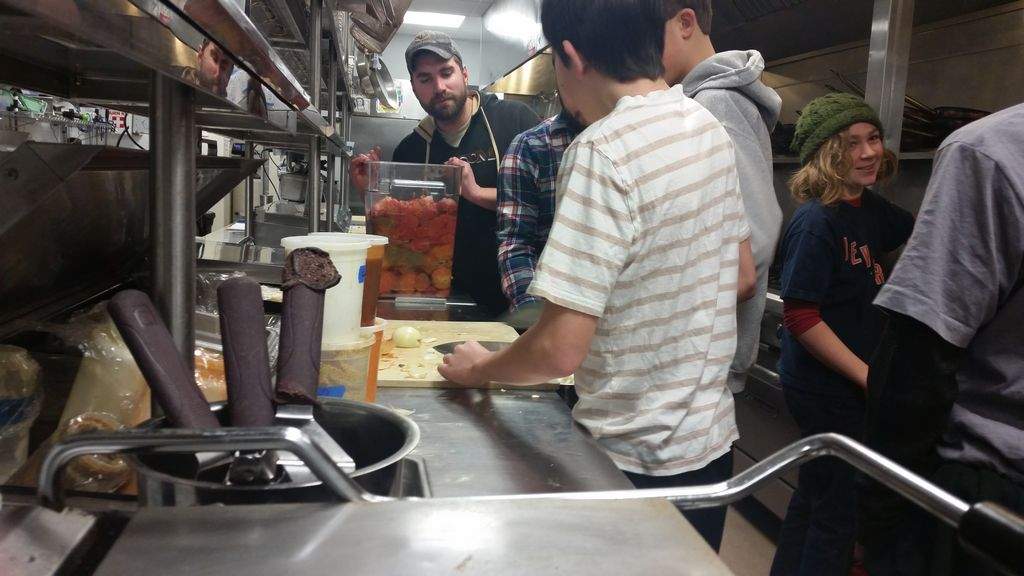
by RVCS | Feb 10, 2017 | Community
Ridge and Valley Charter School students participate in a number of garden projects throughout each year. They save seeds for planting, tend to various gardens and orchard, and ultimately harvest a variety of fruits, vegetables, and herbs. This past season they harvested a bountiful tomato crop. Sixteen quarts of tomatoes were harvested, blanched, peeled, and frozen this fall by students. As they studied food systems, the students explored ways to share their abundant harvest and make an impact on the food system in our area. While furthering their learning of food systems, these middle school students reached out to help the food insecure in our area.
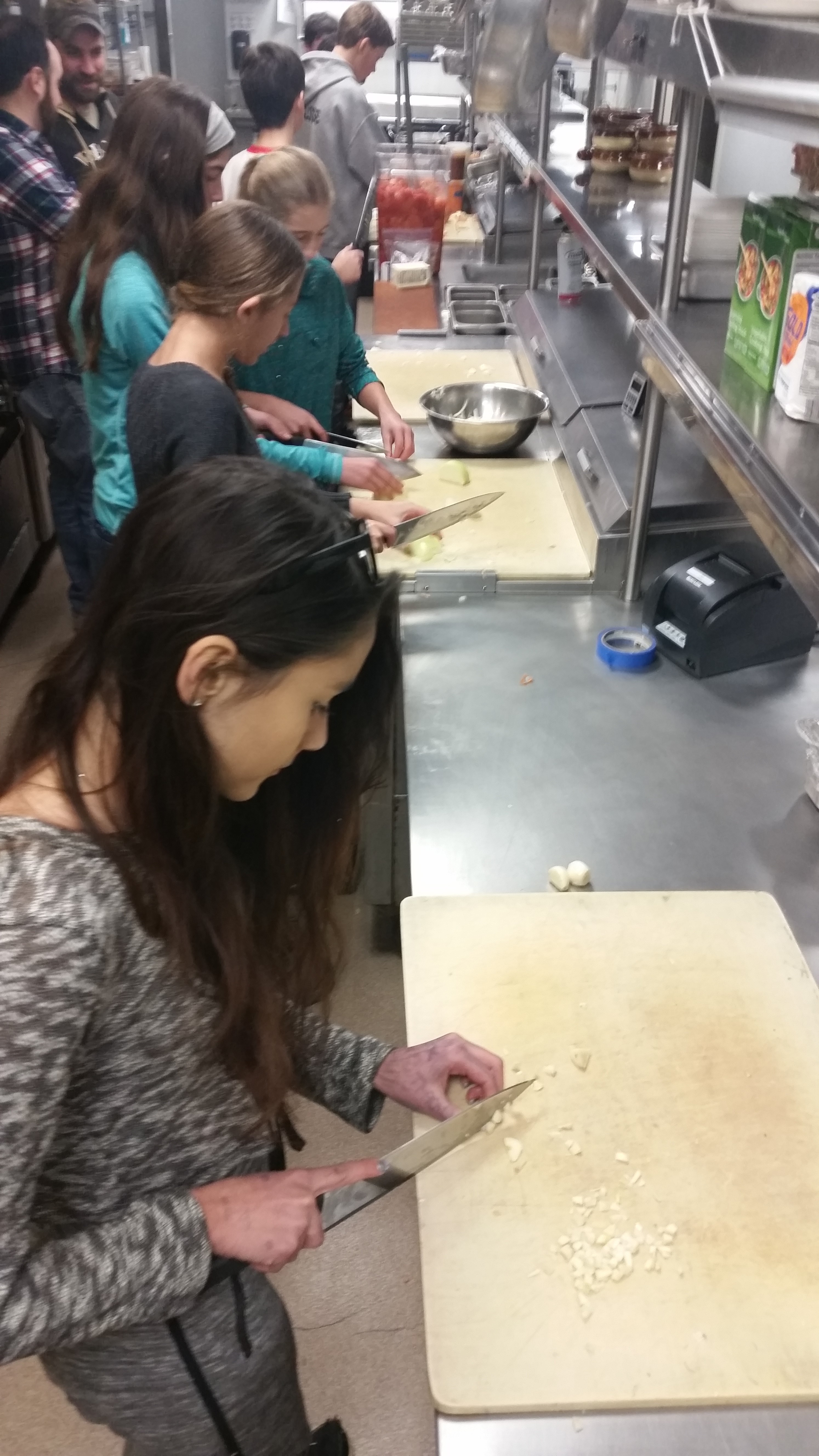
Making Local Connections
During their quest to donate the organic food grown in their garden and volunteer at a local soup kitchen, the students connected with a local Blairstown establishment, Buck Hill Brewery and Restaurant, to prepare food for donation in the restaurant’s board certified commercial kitchen. A date was set, and delicious tomato soup was made with guidance from Buck Hill’s head chef. Chef Brett shared his expertise and tricks of the trade with the students. The organic and locally grown tomato soup was shared with Manna House in Newton. Many of the students also participated in serving the meal, as well.
Ridge and Valley Experiences Provide Students with a Sense of Purpose
This experience added a sense of authentic purpose to the students’ work, as well as enhanced their experience learning to grow food and study of systems. Ridge and Valley Charter School is grateful to Buck Hill Brewery and Restaurant and Manna House for their willingness to partner with our students in their efforts to make a difference.
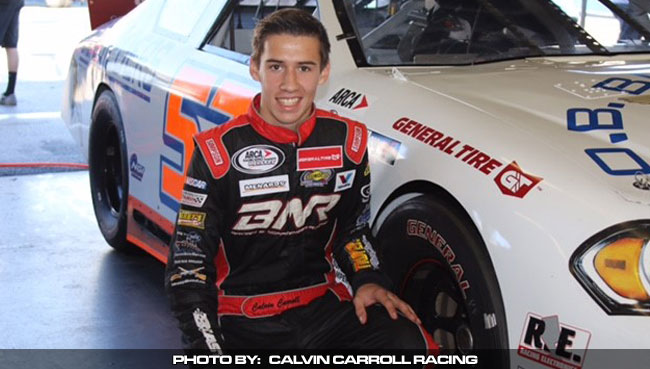
by RVCS | Jan 29, 2017 | News
Ridge and Valley Charter School graduate, Calvin Carroll, is making a splash in the world of stock car racing. At just 16 years old, racing has always been his passion. As a student at Ridge and Valley Charter School he apprenticed with an auto mechanic shop during “Independent Study” time. Independent Study at RVCS is a dedicated time when students are involved in the process of identifying personal interests, setting goals, finding resources, planning and following through on projects, documenting their process and self-reflecting and sharing outcomes. This independent study opportunity for students comes from RVCS’ fundamental belief that all children are intrinsically motivated learners and are ultimately capable of directing their own learning.
This could not be more true for Calvin whose hard work, passion and dedication are certainly paying off. He recently competed at Daytona International Speedway during two days of the ARCA Racing Series. He also plans to run for Rookie of the Year honors with the NASCAR Whelen Modified tour. To learn more about Calvin’s racing career and his great showing at Daytona recently check out this article in Race Pro Weekly.
Read the news article featured on raceproweekly.com
here
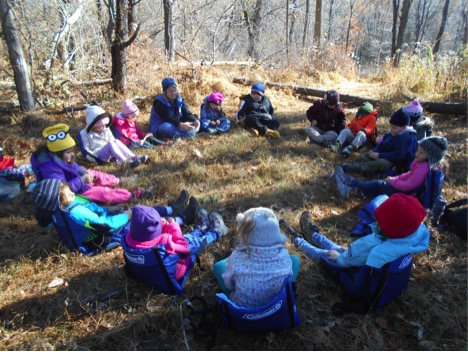
by RVCS | Dec 5, 2016 | Integrative Learning
The governance model at Ridge and Valley Charter School (RVCS) is collaborative, circle-based modified consensus. Students, teachers, trustees, and families use the circle form for meetings, discussions, and decision-making in small and large groups and in committees.
The Circle, an Ancient Form of Meeting
The circle, or council, is an ancient form of meeting that has gathered human beings into respectful conversation for thousands of years and has served as the foundation for many cultures. What transforms a meeting into a circle is the willingness of people to shift from informal socializing or opinionated discussion into a receptive attitude of thoughtful speaking and deep listening. This practice is expanding widely into corporations, non-profit and NGO boards, education, healthcare, community activism, and religious communities as a highly applicable form of collaborative governance.
The Circle Way
Ridge and Valley Charter School has benefited from resources and guidance from mentors connected to the organization PeerSpirit, who train organizations in The Circle Way. This practice is a “body of work combining ancient lineage and modern social technology into a refined, lightly structured group process.” The two founders, Christina Baldwin and Ann Linnea, taught, applied and evolved this work in a worldwide 25-year writing and teaching cycle.
RVCS has refined its own circle practice through onsite trainings, study of the book “The Circle Way – A Leader in Every Chair,” by Baldwin and Linnea, and the informative PeerSpirit website (www.peerspirit.com). These tools have supported the evolution and development of school-wide practices of a foundational model of circle governance.
Circle-Based Collaboration Foster Relationships and Responsibility
The trustees and staff credit the responsibility and relationships fostered by circle-based collaboration to long-term success of the school. Both the children and adults seek to model the personal responsibility and mutual respect necessary to work in a circle of peers: to ask for what you need and to offer what you can, in support of the explicit shared intention of the group.
Ask students at Ridge and Valley Charter School what “circle” is and they will have a lot to share. They will say it is how they help to govern their classroom; that it is an opportunity for them to listen to new ideas while having a voice of their own. The Circle Way fosters a sense of confidence and empowerment in these students that they will carry on into adulthood.
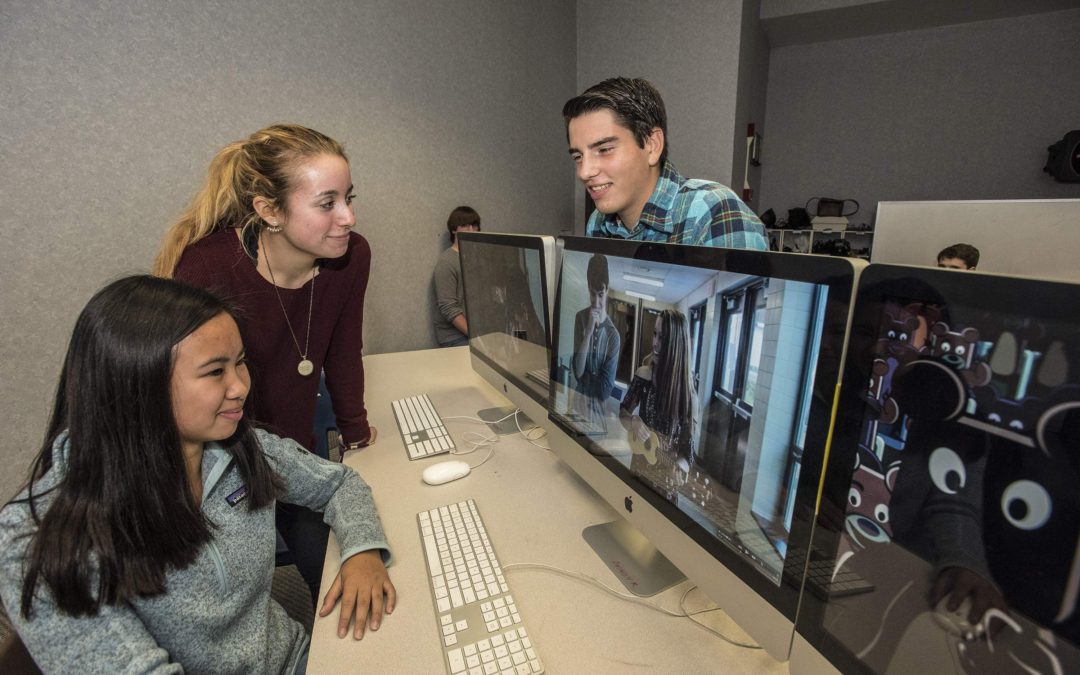
by RVCS | Oct 31, 2016 | News
Ridge and Valley Charter School graduate and budding filmmaker, Sadie Price-Elliot, had her film “Patience” accepted into the Student Film Showcase at this year’s Black Bear Film Festival in Milford, PA. Currently, a sophomore at Sussex County Technical School studying cinematography, Sadie wrote and directed the film when she was just a freshman. The festival spotlights independent filmmakers and their work with screenings held at a variety of venues throughout the town.
For more information about Sadie’s accomplishments check out the write up in the ![]() NJ Herald here!
NJ Herald here!
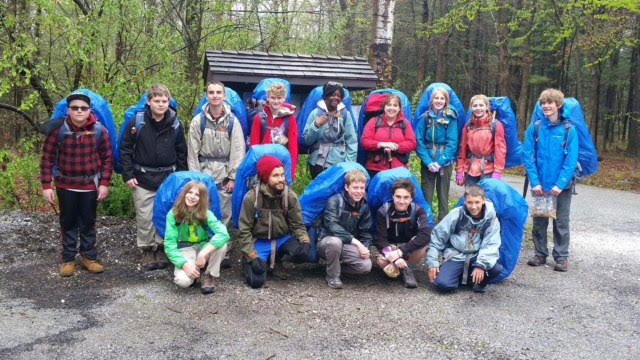
by RVCS | Oct 18, 2016 | Integrative Learning
Outdoor Overnight Expeditions: A Cornerstone of the Ridge and Valley Charter School Experience
Overnight and expeditionary experiences that are embedded into the curriculum, from kindergarten through graduation, offer some of the most important and exciting opportunities to Ridge and Valley Charter School (RVCS) students. Not only are these experiences a critical element in the development of self-confidence and a love of the natural world, but they also provide a rich, integrated way to learn and apply the skills and knowledge that the students are studying throughout the year.
Consider this quote from a study by the Association of Fish and Wildlife Agencies on this topic:
…the benefits of outdoor skills education [include] improved interpersonal and intrapersonal skills; environmental awareness and stewardship ethics; physical, mental, and social health; and ability to learn and concentrate.”
This is only one of many formal research studies that document the numerous and compelling positive outcomes that are a result of expeditionary types of experiences like the ones that are integral to the RVCS curriculum.
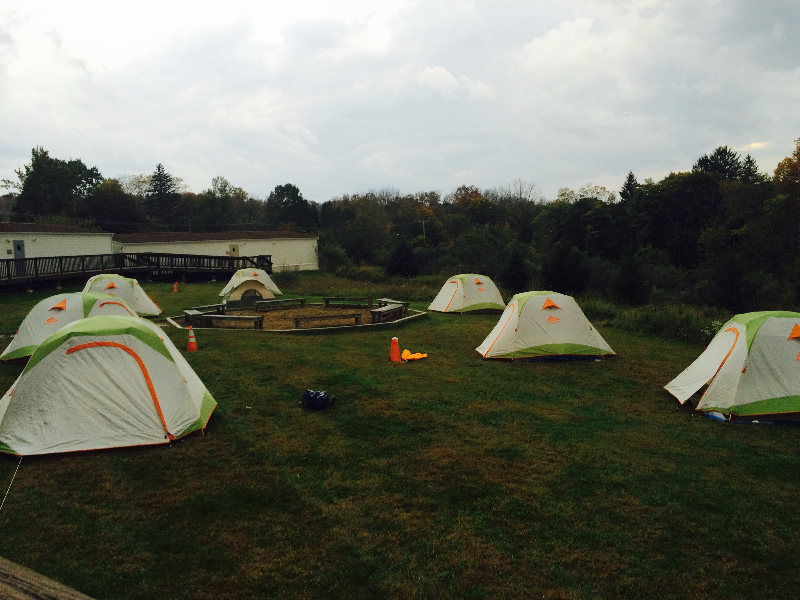
Benefits of Outdoor Overnight Expeditions
Many students often report that these experiences are the most memorable and life changing of all the experiences they have during their time at RVCS. This is not a surprise or a coincidence. The following is a list of many of the benefits of expedition style experiences:
- Confidence, self-esteem, maturity, self-awareness and independence
- The ability to be part of a team, to lead and be led (setting up camp, making sure everyone gets to the top of the summit, delegating and sharing in tasks, etc.)
- An ability to communicate with others day-to-day and under pressure (ensuring everyone in the team knows what is going on)
- An understanding of the importance of humility, empathy, compassion, gratitude and pride
- Organizing, planning and preparing
- Problem solving, flexibility, adaptability and initiative
- Skills to assess and manage risk
- Financial management, budgeting and the value of money (fundraising/planning for an expedition fosters entrepreneurial skills and gives real and relevant business experience)
- Knowledge to travel safely and responsibly
- Learning from mistakes
- Reflection and debrief reinforce everything that is learned
- Participants can use the expedition to provide evidence of personal key skills on college and/or job applications
- The lessons learned, cultures explored and environments visited during an expedition meet and go beyond the standards found within multiple academic content areas
Taking the Classroom Outdoors
We are fortunate to be located in an incredibly rich area in terms of natural and recreational resources. We have easy access to the Appalachian Trail, Delaware Water Gap National Recreation Area, the Paulinskill Trail, as well as numerous YMCA camps and outdoor centers. At RVCS, we continue to hone a developmentally appropriate, K-8 expeditionary scope and sequence of skills and experiences connected to the curriculum lenses for each academic year. Teachers, referred to as “Guides,” fold content and assessment into these experiences, building from one year to the next, so that by the time students graduate from RVCS they will have had a variety of overnight experiences and practiced a wide range of outdoor skills, all while engaged in content rich studies. Often times, due to the high engagement of the students, these experiences feel less like “school” or academic learning and more like fun adventures, thus on the surface and from an outside view their value may be overlooked.
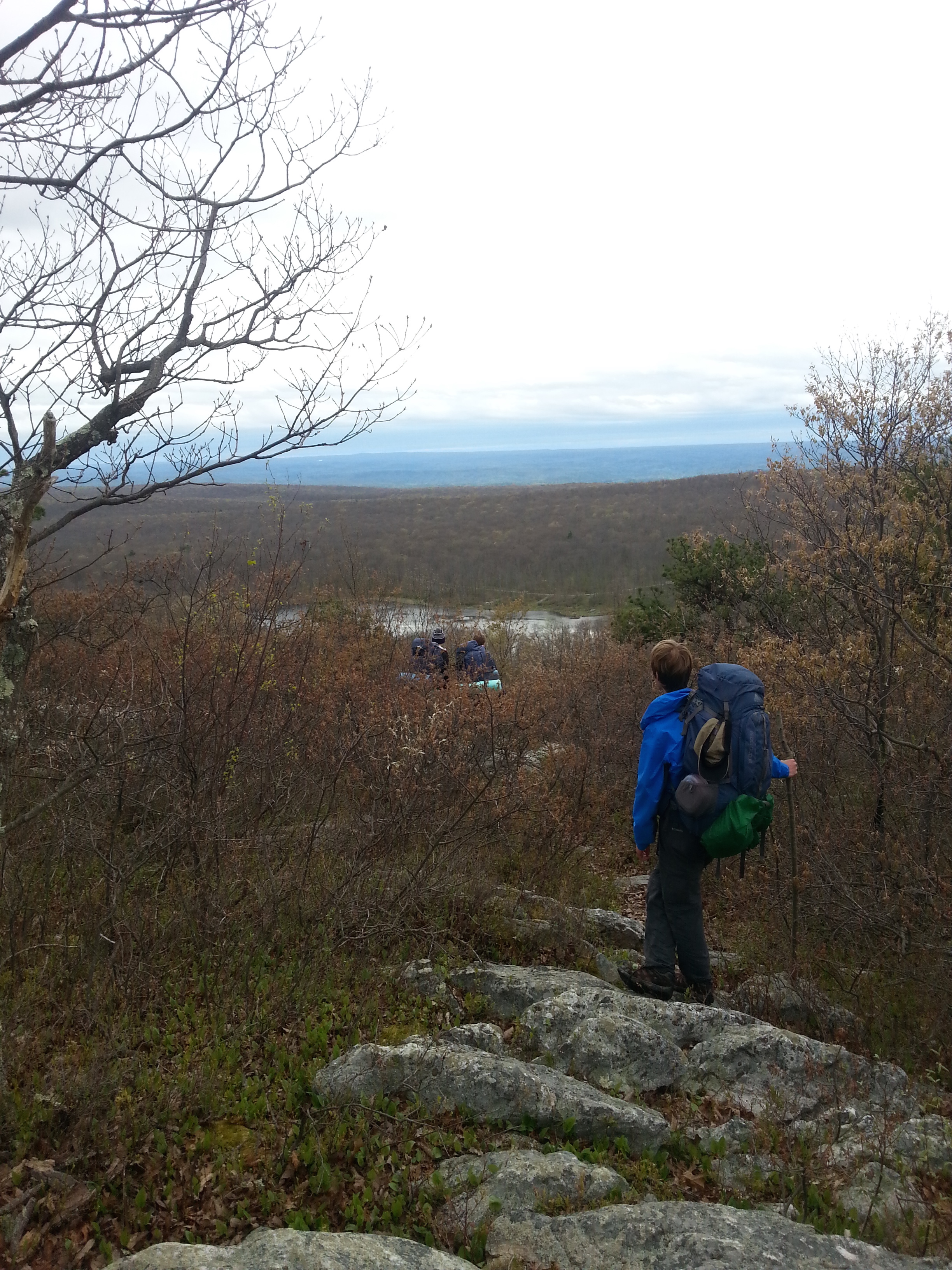
Planning for an Outdoor Overnight Expedition
A great deal of planning occurs behind the scenes prior to each expedition to allow for the students to have a safe, developmentally challenging experience. Guides are trained in the skills necessary to handle a variety of emergency situations and help facilitate a group working through the above mentioned challenges. Additionally, during each trip, there is consistent contact between trip leaders and emergency contacts back at RVCS to continue to evaluate and adjust for safety and/or changing weather conditions. This planning and on-going assessment of the group is what allows for these safe, but transformative experiences.
The Academic, Physical & Emotional Value of Outdoor Overnight Expeditions
Not only do students engage in experiences that address common core content standards for traditional academic areas, but they also practice and are assessed on a number of mission related goals and standards, as outlined in the RVCS charter agreement with the state of NJ. We are committed to not only teach common core content standards, but also demonstrate that we are achieving our own mission specific goals. The expeditions/overnights are a perfect medium for students to engage in these critical learning experiences, from the planning stage all the way through the trip debrief upon return to the school.
While the expeditions have a quality of adventure and fun, they can also be physically and emotionally challenging. This is as critical a part of the experience as the physical skills and academic content. Students of all ages are sometimes anxious about being away from family or, often in the older grades, the physical challenge of backpacking or dealing with uncomfortable weather conditions. These are all normal feelings and in the end add to the incredible sense of accomplishment that comes with facing and overcoming a challenge. While students prepare for the experiences over the course of the year, it’s not easy to simulate all of the physical and emotional challenges that will actually occur on an expedition and this experience with a real-world challenge actually adds to the overall value of the experience. It is not uncommon for students to struggle somewhat, either individually or as group, during parts of the trip. It’s often that feeling of elation at overcoming an obstacle that solidifies the experience for the student. These types of breakthroughs are incredible moments that we hope all students have at some point during their RVCS journey.
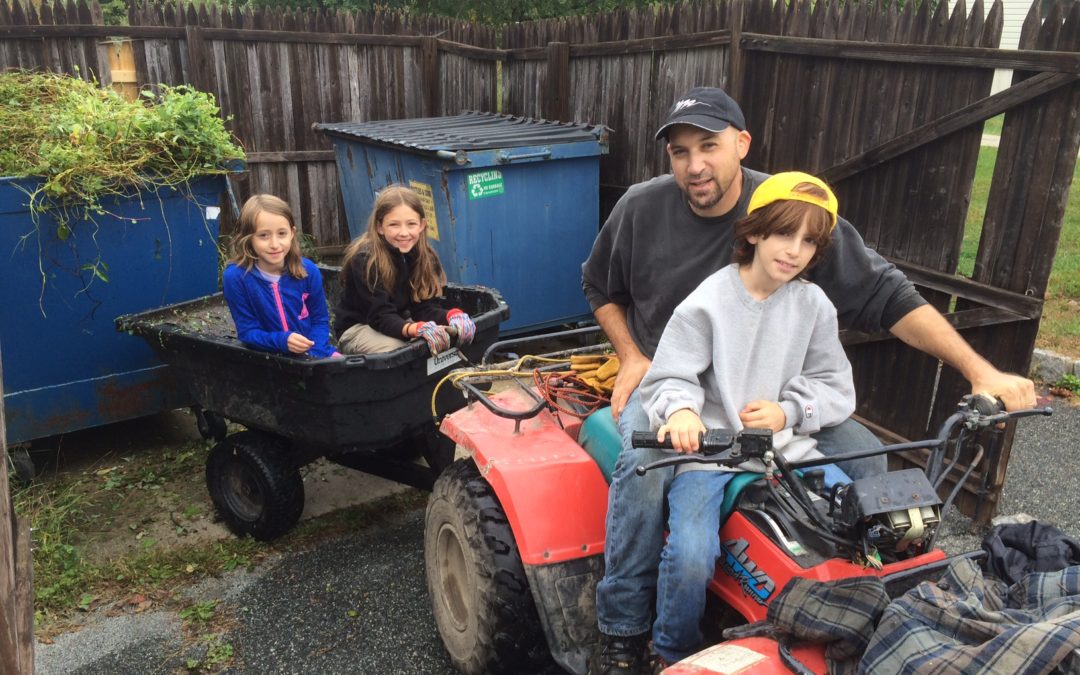
by RVCS | Oct 10, 2016 | Community
Pictured: Emma Corbo, Kathryn Zurovchak, Dad Niko Corbo and Vincent Corbo help clear underbrush during RVCS’ October 1 Community Service Day.
Ridge and Valley Charter School Community Service days, like the recent gathering on October 1, provide an opportunity for students, families, staff and trustees to come together and help make the RVCS campus a better place. On Community Service Day, volunteers take on site management tasks, classroom prep activities and a wide range of helpful jobs to beautify the property and prepare classrooms for students. Sustainability means taking care of the resources, materials and relationships around us. And we believe that when students and families connect to the operational dynamics of their school, the learning is deeper and students can better understand their school as a local community-based human experience.
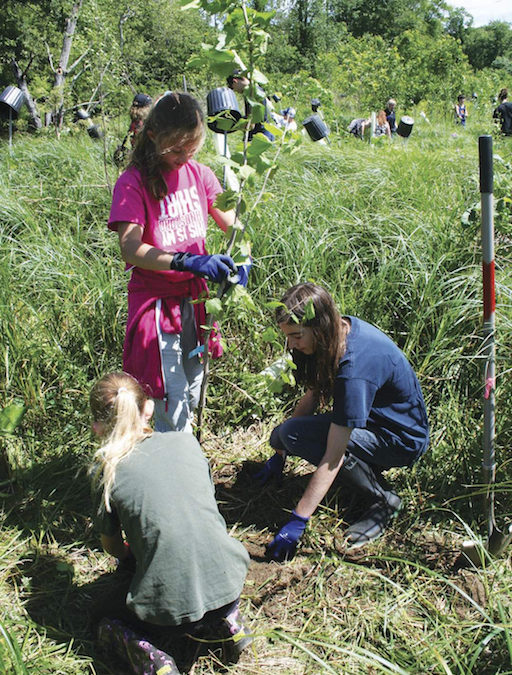
by RVCS | Jul 25, 2016 | Community
Ridge and Valley Charter School student volunteers helped to plant 163 trees on the banks of the Paulins Kill in Stillwater, New Jersey to mitigate invasive species that prevent reforestation and ultimately, cause erosion. After learning about watersheds throughout the school year, students were compelled to volunteer to help the Paulins Kill watershed that runs behind their school.
Student Volunteers & the Restoration Effort
Ridge and Valley Charter School partnered with the Stillwater Environmental Commission and the Wallkill River Watershed Management Group who have been working on a reforestation and restoration project since 2012. The planting of trees is part of a larger project to mitigate invasive species and prevent erosion.
While volunteering, students were able to see the stream bank erosion first hand and by helping to plant trees were an active part of the restoration effort. Ridge and Valley Charter School student volunteers hope to come back to measure the survival rate of the trees, fix the tubes that are protecting those trees, and track the progress of the area.
Service Learning Opportunities at Ridge and Valley Charter School
This is just one example of the many voluntary service learning opportunities (integrating meaningful community service with instruction and reflection) that students at Ridge and Valley Charter School undertake each year.
For more information about the students’ volunteer experience check out the write up in the NJ Herald here!
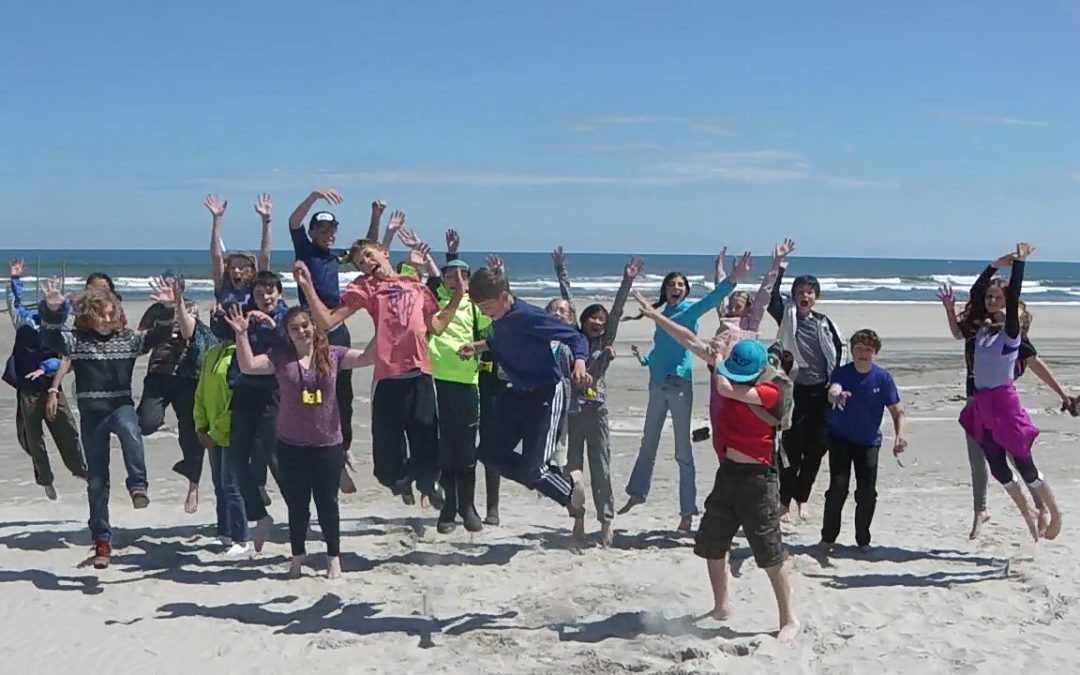
by Dan Egan | Jul 5, 2016 | Integrative Learning, Natural World
Sixth and seventh grade students from Ridge and Valley Charter School (RVCS) went on a service learning expedition recently to the Delaware Bay. The students volunteered with the American Littoral Society and the Western Hemisphere Shorebird Reserve Network. Expeditions such as this are an integral part of the RVCS curriculum.
Service Learning as Extension of Students’ Work
This service learning expedition was deeply rooted in the students’ work throughout the year. Their studies included collecting information through research, formulating opinions and arguments, identifying counter-arguments and rebuttals, understanding natural history, collecting and analyzing data, exploring culture, civilization, and how we as humans use resources, as well as fostering a growth mindset leading to a better understanding of “Who am I as a learner, and as a human being?”
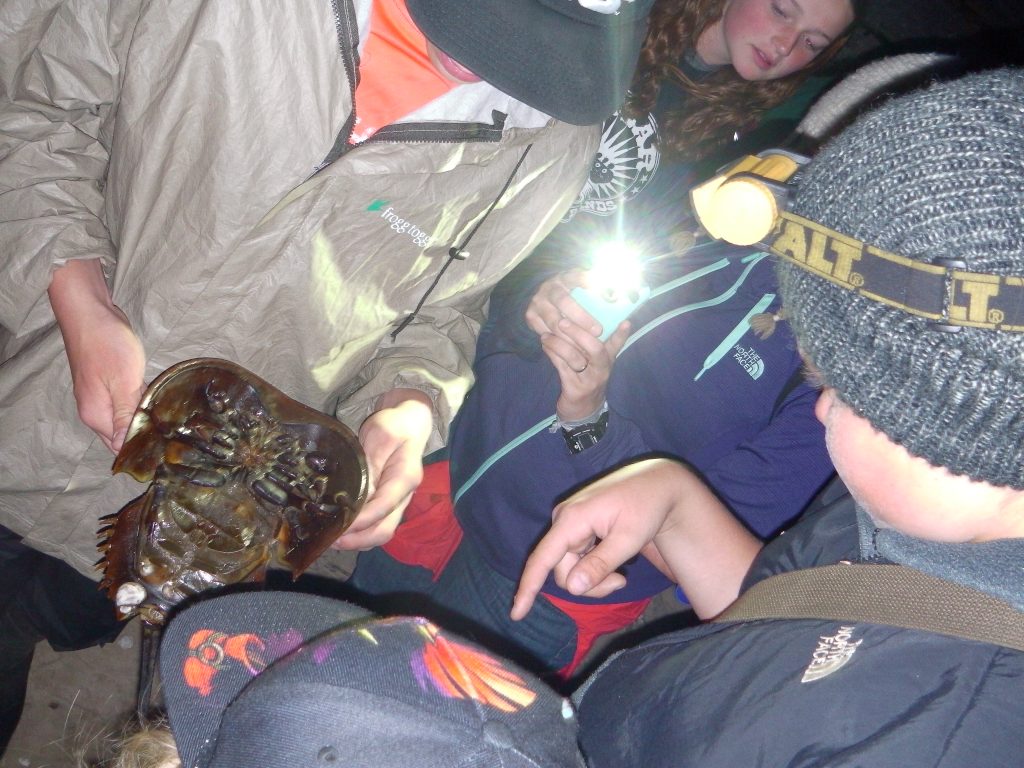
Students Work Alongside Professionals
While on the overnight service learning expedition, students became citizen scientists working side by side with professionals from the American Littoral Society, whose mission is to protect marine life, protect the coastal ecosystems from harm, and to empower others to do the same. They also worked with professionals from the Western Hemisphere Shorebird Reserve Network, whose mission is to conserve shorebirds and their habitats through a network of key sites across the Americas.
Tagging Horseshoe Crabs
Student scientists worked in small groups to tag horseshoe crabs over two nights. After drilling to create a small hole in the side of the horseshoe crab’s carapace or shell (the crabs don’t have nerves in the shells) students installed a white, round tag with an identification number and contact number. These are used to track the migration of the crabs from night to night and spawning season to season. It allows scientists to better understand whether crabs prefer to return to the same areas to spawn or if they move more freely up and down the eastern coast.
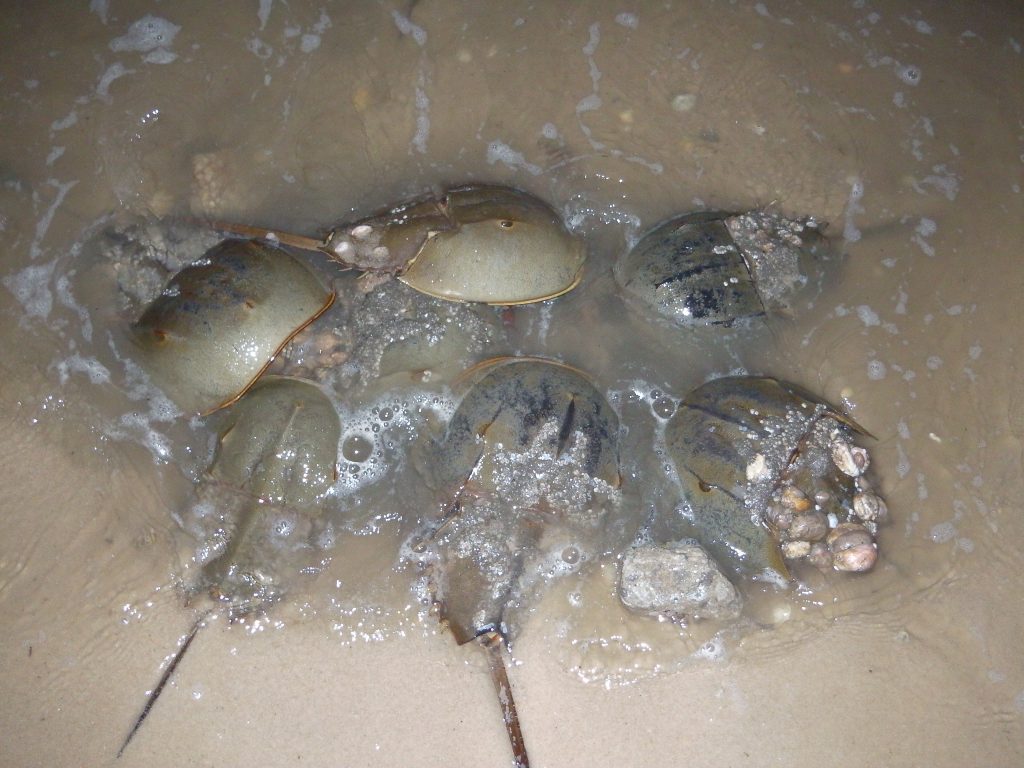
Measuring the Horseshoe Crab Population
As well as tagging crabs, student biologists used square meter quadrats and a measuring rope marked off in meter measurements to collect information on how many crabs are coming onto the beach during the mating season. This data, collected by a representative from the Western Hemisphere Shorebird Reserve Network, will be submitted to the U.S. Fish and Wildlife Service in an annual report to further analyze the population of the horseshoe crabs and monitor trends in their recovery from near extinction (90% decrease in population during the 1990s and early 2000s).
Throughout this important service learning work, students also combed the beach, flipping crabs who were stuck upside down and who would otherwise likely die in the heat of the day, while scanning for previously tagged crabs, documenting their identification number, gender, and physical health, including any visible injuries. This data, too, will be submitted with the census to the Fish and Wildlife Service.
Exploring the Cape May National Wildlife Refuge
Each student exemplified maturity, leadership, and professionalism during their 2-3 hour long evening service learning volunteer sessions. During the day, students and their teachers (referred to as “Guides” at RVCS) traveled to the Cape May National Wildlife Refuge on the Atlantic Ocean, just south of Wildwood Crest. Students scanned the beach for shorebirds, observing semipalmated sanderlings, semipalmated plovers, and an American oystercatcher. The students also spent some time running along Two Mile Beach, just south of the refuge, discovering horseshoe crabs buried in the sands along the high tide lines while exploring the tidal pools for shells, crabs, and a starfish.
Post Service Learning Expedition Observations
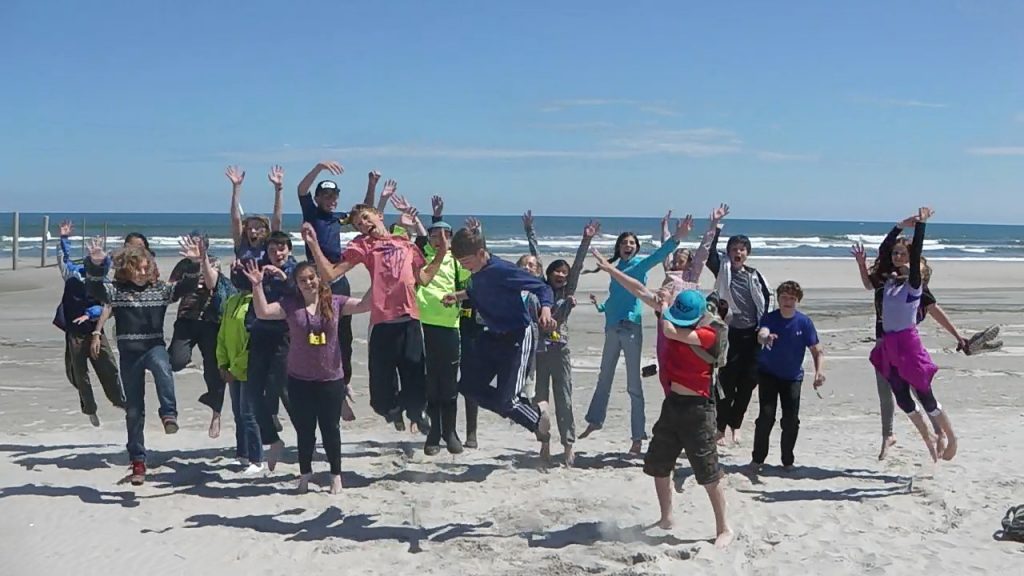
After the service learning trip, one of the students spoke about their experience in this way,
I have been challenged by stepping outside of my comfort zone and working with people that I don’t have a lot of experience with. I have learned that the people in the community and local environment are very patient and caring. I have learned that I want to do more work like this over the summer and when I’m older helping marine life and endangered species. I think the most important thing I learned is that I am making history right now and that every thing I do has an effect.
The Delaware Bay service learning expedition was not only educational, but was also an experience these students at Ridge and Valley Charter School will never forget.

by Grace Gordon | Jun 28, 2016 | Natural World
On a cold morning in March as my students saunter into the classroom, I hear the words, “Yay, it’s Forest Friday!” I frequently hear this announcement on Friday mornings as students arrive to the Honeybee classroom. My co-teacher, Lisa, and I are often packing our wagon with Forest Friday supplies and preparing tea for later in the morning when fingers begin to chill and energy runs low. Excited and ready for a day outside, students eagerly prepare by putting on their appropriate gear for the weather, because come rain or snow, the students know that we will be outside for at least three hours.
Sit Spots and Nature Connection
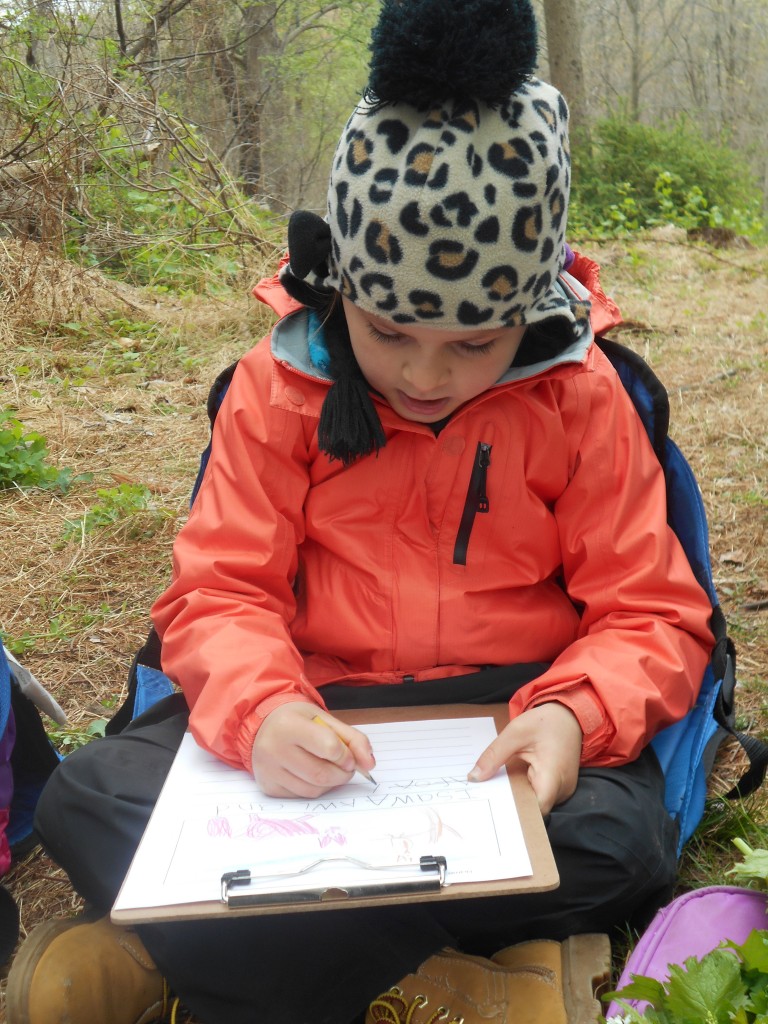
While the entire time we are outside is beneficial, the most important part of Forest Friday is the time at our sit spots. A sit spot is a special place in nature that one goes to often to sit and observe what is going on around them. Jon Young, a famous naturalist, tracker, and author, describes them as the “magic pill” for nature connection. In school, we use them as a way to connect to the local landscape, and as a jumping off point to tie together many topics we study in the classroom. By using sit spots in this way, it allows us to create an experience where our students take the the academic skills they are learning in the classroom and use them in an authentic way.
The standards-based academics can be seen from the moment the students circle up after their cooperative, free play time in the woods. They quickly run and grab their foldable chair and form a circle. We take turns reminding each other of the various senses and awareness skills we should use during our sit spots. If we have the pleasure of having a parent volunteer join us that day, the kids also take a moment to tell them what sit spots are and how we experience them. Next, we pull down the “veil of silence”, signifying that it is time to honor only the noises of the forest. Finally, we head off slowly “fox walking”, a more complex way to tiptoe, to our sit spots.
Each child has their very own sit spot, and they know exactly where they are headed once the “veil of silence” has been pulled down. The children form a deep connection with their individual sit spots and when a guest joins us for the day, such as a parent volunteer, it is often a place they are very excited to share.
Connecting to the Local Environment is Paramount
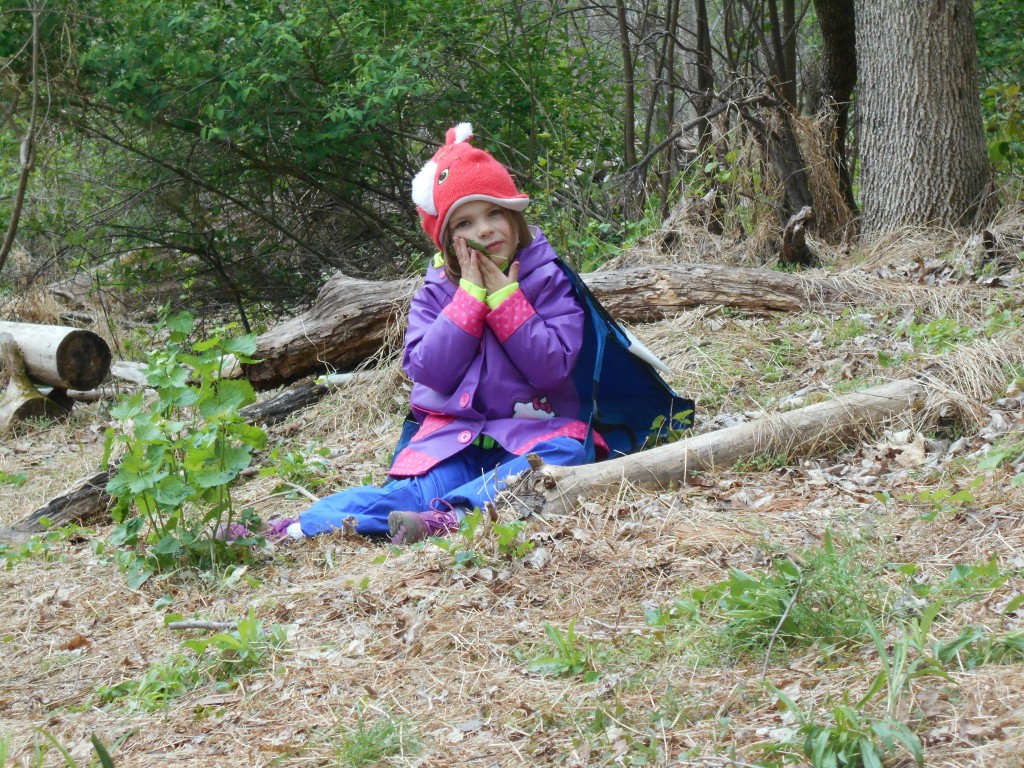
This connection to our local environment is considered paramount by professor and author, Dr. David Sobel, who specializes in place-based education. The idea is to not spend too much time focusing on studying a far away bioregion, but rather to see the beauty and learn about our own valuable flora and fauna in our own backyards. By taking the time to study the environment in which one lives and experiencing it first hand, a child will form a connection and gain knowledge of the land. This way of learning is more meaningful than reading about a landscape in a book or seeing it in a movie.We sit for ten solid minutes. This is a lot to ask of some five and six year olds, but we have increased the time throughout the year to match their greater stamina. The hope is that they will realize that the more still they sit, the more they will see and hear and experience.
As we sit there, I see a student cup their hands behind their ears as they use their “deer ears” to hear more. I see another student quietly digging a small hole with a stick they found at their sit spot. They use their “racoon touch” as they run their fingers through the dirt. Some have a relaxed look on their faces as they lean back in their camp chairs and look up at the treetops and the sky. Another student is intensely following an insect as it walks across the log in front of them. All of these activities are acceptable for sit spot time. It is these experiences that the students will use in their journal entries
After ten minutes sitting and observing the world around us, I softly bang a drum, which is the signal that sit spot time is over. The students quietly walk back to our circle area, sit down and begin drawing and writing their observations. One student is writing about a spider that visited him at his sit spot. Another student draws a picture of a dark bird that soared overhead. Their focus during this time is incredibly intense. All I can hear are the birds chirping and pencils and crayons being pulled this way and that way across their papers. When people begin finishing up, we have circle, where we take turns sharing the various stories of what happened during our individual sit spots. As each child speaks, the rest of us listen and sip on warm, berry flavored tea. The tea heats my insides and perks me up, as it seems to do for the children as well.
Circle Time and Tea
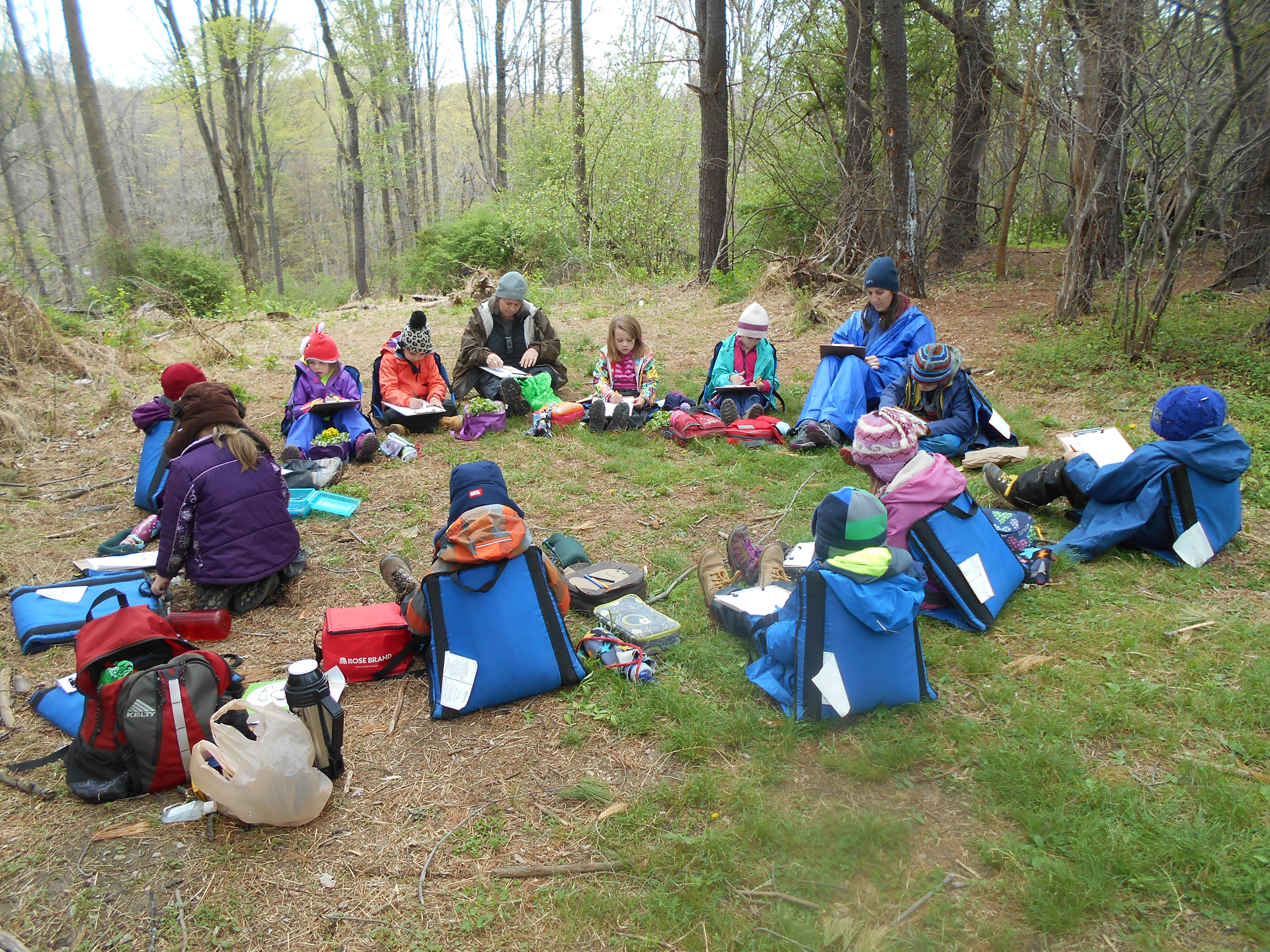 This circle time gives students a chance to work on all areas of literacy, which include reading, writing, speaking,and listening. From writing down their experience to listening to their classmates, the students are using their literacy skills in a way that is relevant to them. These skills are experienced directly, rather than indirectly, creating a more meaningful educational experience. Each individual journal entry is placed in the child’s nature journal which has become a record of the advances the children are making in their literacy studies each week.
This circle time gives students a chance to work on all areas of literacy, which include reading, writing, speaking,and listening. From writing down their experience to listening to their classmates, the students are using their literacy skills in a way that is relevant to them. These skills are experienced directly, rather than indirectly, creating a more meaningful educational experience. Each individual journal entry is placed in the child’s nature journal which has become a record of the advances the children are making in their literacy studies each week.
Wrapping Up
After each student has shared their sit spot story, the students dash off for another short cooperative free play time. We will make the hike back to the classroom after a math activity and more cooperative play time. It is amazing how fast three hours can go by when you are outside.
I announce the plan to head in and one student asks, “Why is it time to go in?” I explain that we need to eat lunch and let people use the bathrooms. That response is followed by, “But, I’m not hungry!” and “But, I don’t need to use the bathroom!” Another student chimes in saying, “I can’t wait until next Forest Friday!” I smile and follow a gaggle of happy and hungry children back to the classroom.
References:
Young, Jon, Ellen Haas, and Evan McGown. Coyote’s Guide to Connecting with Nature. Shelton, WA: OWLLink Media, 2010. Print.
Sobel, David. Place-based Education: Connecting Classrooms and Communities. 2nd ed. N.p.: Orion Society, 2005. Print.



















 This circle time gives students a chance to work on all areas of literacy, which include reading, writing, speaking,and listening. From writing down their experience to listening to their classmates, the students are using their literacy skills in a way that is relevant to them. These skills are experienced directly, rather than indirectly, creating a more meaningful educational experience. Each individual journal entry is placed in the child’s nature journal which has become a record of the advances the children are making in their literacy studies each week.
This circle time gives students a chance to work on all areas of literacy, which include reading, writing, speaking,and listening. From writing down their experience to listening to their classmates, the students are using their literacy skills in a way that is relevant to them. These skills are experienced directly, rather than indirectly, creating a more meaningful educational experience. Each individual journal entry is placed in the child’s nature journal which has become a record of the advances the children are making in their literacy studies each week.